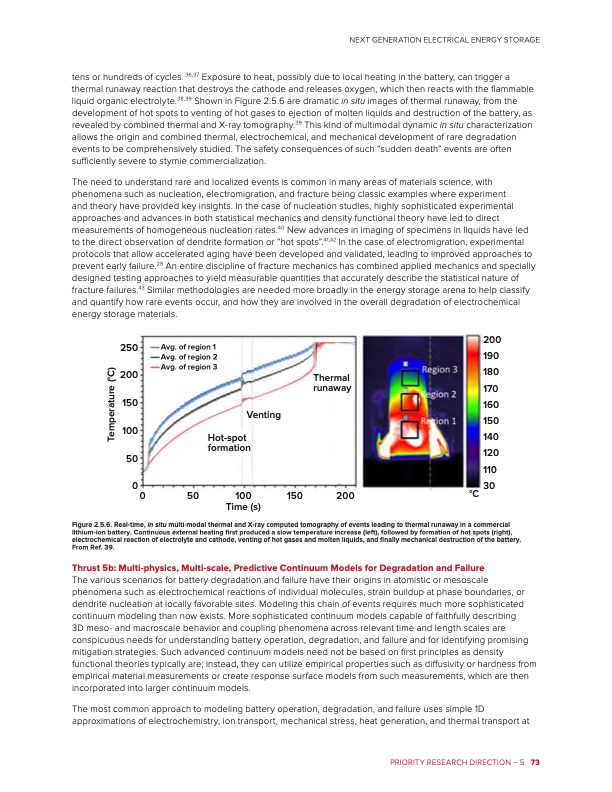
PDF Publication Title:
Text from PDF Page: 079
tens or hundreds of cycles. 36,37 Exposure to heat, possibly due to local heating in the battery, can trigger a thermal runaway reaction that destroys the cathode and releases oxygen, which then reacts with the flammable liquid organic electrolyte.38,39 Shown in Figure 2.5.6 are dramatic in situ images of thermal runaway, from the development of hot spots to venting of hot gases to ejection of molten liquids and destruction of the battery, as revealed by combined thermal and X-ray tomography.39 This kind of multimodal dynamic in situ characterization allows the origin and combined thermal, electrochemical, and mechanical development of rare degradation events to be comprehensively studied. The safety consequences of such “sudden death” events are often sufficiently severe to stymie commercialization. The need to understand rare and localized events is common in many areas of materials science, with phenomena such as nucleation, electromigration, and fracture being classic examples where experiment and theory have provided key insights. In the case of nucleation studies, highly sophisticated experimental approaches and advances in both statistical mechanics and density functional theory have led to direct measurements of homogeneous nucleation rates.40 New advances in imaging of specimens in liquids have led to the direct observation of dendrite formation or “hot spots”.41,42 In the case of electromigration, experimental protocols that allow accelerated aging have been developed and validated, leading to improved approaches to prevent early failure.28 An entire discipline of fracture mechanics has combined applied mechanics and specially designed testing approaches to yield measurable quantities that accurately describe the statistical nature of fracture failures.43 Similar methodologies are needed more broadly in the energy storage arena to help classify and quantify how rare events occur, and how they are involved in the overall degradation of electrochemical energy storage materials. Hot-spot formation 50 100 Time (s) 150 Venting Figure 2.5.6. Real-time, in situ multi-modal thermal and X-ray computed tomography of events leading to thermal runaway in a commercial lithium-ion battery. Continuous external heating first produced a slow temperature increase (left), followed by formation of hot spots (right), electrochemical reaction of electrolyte and cathode, venting of hot gases and molten liquids, and finally mechanical destruction of the battery. From Ref. 39. Thrust 5b: Multi-physics, Multi-scale, Predictive Continuum Models for Degradation and Failure The various scenarios for battery degradation and failure have their origins in atomistic or mesoscale phenomena such as electrochemical reactions of individual molecules, strain buildup at phase boundaries, or dendrite nucleation at locally favorable sites. Modeling this chain of events requires much more sophisticated continuum modeling than now exists. More sophisticated continuum models capable of faithfully describing 3D meso- and macroscale behavior and coupling phenomena across relevant time and length scales are conspicuous needs for understanding battery operation, degradation, and failure and for identifying promising mitigation strategies. Such advanced continuum models need not be based on first principles as density functional theories typically are; instead, they can utilize empirical properties such as diffusivity or hardness from empirical material measurements or create response surface models from such measurements, which are then incorporated into larger continuum models. The most common approach to modeling battery operation, degradation, and failure uses simple 1D approximations of electrochemistry, ion transport, mechanical stress, heat generation, and thermal transport at NEXT GENERATION ELECTRICAL ENERGY STORAGE 250 200 150 100 50 00 Avg. of region 1 Avg. of region 2 Avg. of region 3 Thermal runaway 200 200 190 180 170 160 150 140 120 110 °C 30 PRIORITY RESEARCH DIRECTION – 5 73 Temperature (°C)PDF Image | Next Generation Electrical Energy Storage

PDF Search Title:
Next Generation Electrical Energy StorageOriginal File Name Searched:
BRN-NGEES_rpt-low-res.pdfDIY PDF Search: Google It | Yahoo | Bing
Sulfur Deposition on Carbon Nanofibers using Supercritical CO2 Sulfur Deposition on Carbon Nanofibers using Supercritical CO2. Gamma sulfur also known as mother of pearl sulfur and nacreous sulfur... More Info
CO2 Organic Rankine Cycle Experimenter Platform The supercritical CO2 phase change system is both a heat pump and organic rankine cycle which can be used for those purposes and as a supercritical extractor for advanced subcritical and supercritical extraction technology. Uses include producing nanoparticles, precious metal CO2 extraction, lithium battery recycling, and other applications... More Info
| CONTACT TEL: 608-238-6001 Email: greg@infinityturbine.com | RSS | AMP |